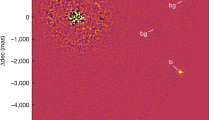Abstract
The discovery1 of a planet around the solar-type star 51 Pegasi marked a watershed in the search for extrasolar planets. Since then, seven other planets have been discovered2,3,4,5,6, of which several have surprisingly short orbital periods, like the planet around 51 Peg. These planets were detected using the indirect technique of measuring variations in the Doppler shifts of lines in the spectra of the primary stars. But it is possible that regular oscillations of the stars themselves (or other effects) could mimic the signature of the planets, particularly the short-period planets. The apparent lack of spectral7 and brightness8 variations, however, led to widespread acceptance that there is a planet around 51 Peg. This conclusion was challenged by the observation9 of systematic variations in the line shapes of 51 Peg, which suggest stellar oscillations10. If these observations are correct, then there is no need to invoke a planet around 51 Peg to explain the data. Here we report observations of 51 Peg at a much higher spectral resolution than those in ref. 9, in which we find no evidence for systematic changes in the line shapes. The data are most consistent with a planetary companion to 51 Peg.


Similar content being viewed by others
References
Mayor, M. & Queloz, D. AJupiter-mass companion to a solar-type star. Nature 378, 355–359 (1995).
Marcy, G. W. & Butler, R. P. Aplanetary companion to 70 Virginis. Astrophys. J. 464, L147–L151 (1996).
Butler, R. P. & Marcy, G. W. Aplanet orbiting 47 Ursae Majoris. Astrophys. J. 464, L153–L156 (1996).
Butler, R. P. et al. Three new “51 Peg-type” planets. Astrophys. J. 474, L115–L118 (1997).
Cochran, W. D., Hatzes, A. P., Butler, R. P. & Marcy, G. W. The discovery of a planetary companion to 16 Cygni B. Astrophys. J. 483, 5457–463 (1997).
Noyes, R. W. et al. Aplanet orbiting the star ρ Coronae Borealis. Astrophys. J. 483, L111–L114 (1997).
Hatzes, A. P., Cochran, W. D. & Johns-Krull, C. M. Testing the planet hypothesis: a search for variability in the spectral line shapes of 51 Peg. Astrophys. J. 478, 374–380 (1997).
Henry, G. W., Baliunas, S. L., Donahue, R. A., Soon, W. H. & Saar, S. H. Astrophys. J. 474, 503–510 (1997).
Gray, D. F. Absence of a planetary signature in the spectra of the star 51 Pegasi. Nature 385, 795–796 (1997).
Gray, D. F. & Hatzes, A. P. Nonradial oscillation in the solar-temperature star 51 Pegasi. Astrophys. J. 490, 412–424 (1997).
Tull, R. G., MacQueen, P. J., Sneden, C. & Lambert, D. L. The high-resolution cross-dispersed echelle white pupil spectrometer of the McDonald Observatory 2.7-m telescope. Publ. Astron Soc. Pacif. 107, 251–264 (1995).
12. Marcy, G. W. et al. The planet around 51 Pegasi. Astrophys. J. 481, 926–935 (1997).
Acknowledgements
This work was supported by NASA's Origins of the Solar System Program.
Author information
Authors and Affiliations
Corresponding author
Rights and permissions
About this article
Cite this article
Hatzes, A., Cochran, W. & Bakker, E. Further evidence for the planet around 51 Pegasi. Nature 391, 154–156 (1998). https://doi.org/10.1038/34369
Received:
Accepted:
Issue Date:
DOI: https://doi.org/10.1038/34369
- Springer Nature Limited
This article is cited by
-
A planetary companion for 51 Pegasi implied by absence of pulsations in the stellar spectra
Nature (1998)
-
Back in focus
Nature (1998)





